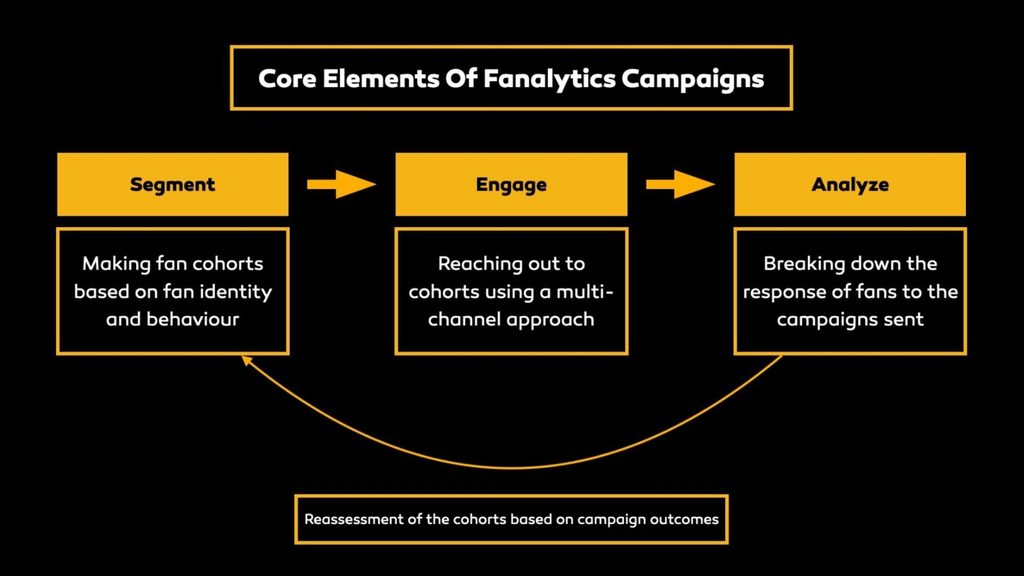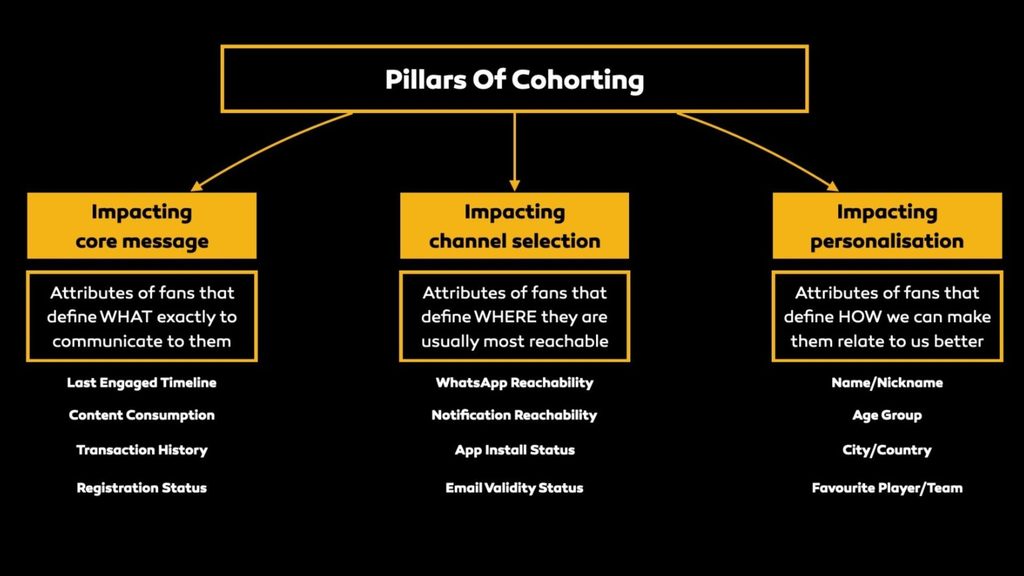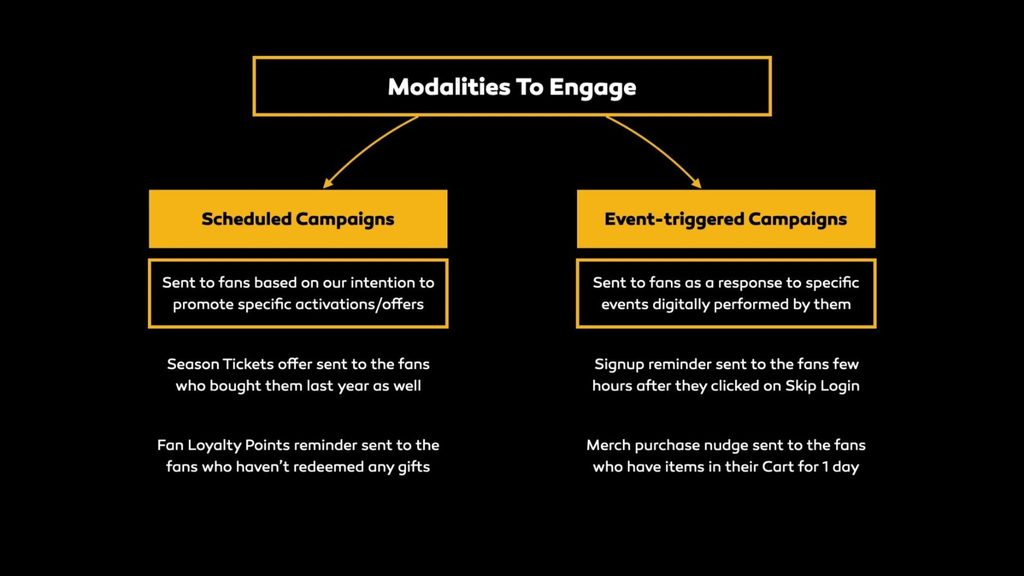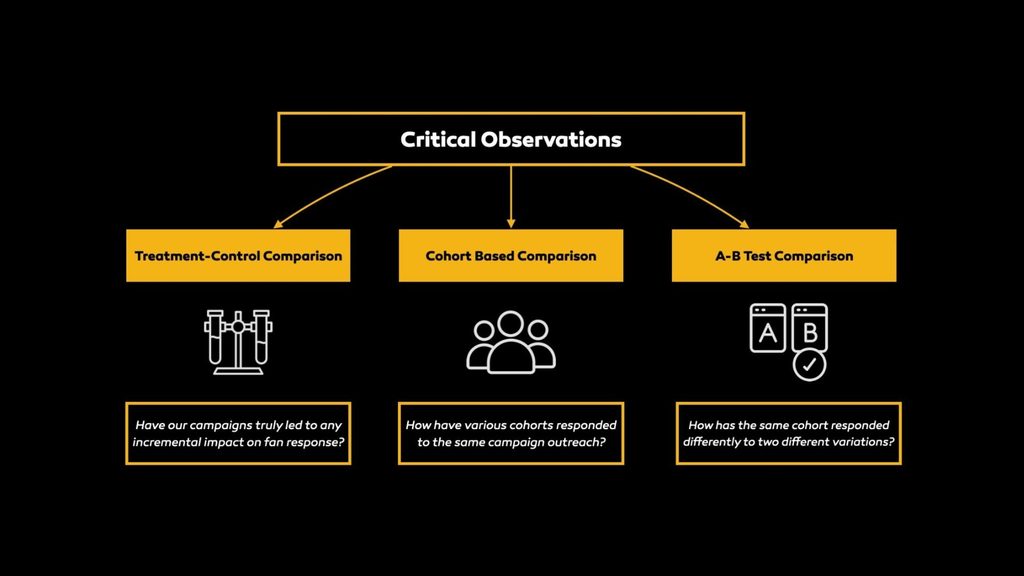Working alongside a highly diverse portfolio of clients from across different regions of the world, one common theme that has stood out over the past few years is that fans have digitally evolved much faster than sports organizations have & it’s high time that this expectation gap is narrowed through Fanalytics solutions. Still wondering what Fanalytics is? Please have a look at our previous edition of the SI Perspective where we have tried to demystify the same for sports organizations with a special focus on the utility of CDPs in the journey.
Let us now go a step further to explore how exactly we can maximize the impact on the fanbase through strategically designed campaigns targeted to specific fan cohorts.

As can be seen in the image above, Fanalytics Campaigns entail the careful execution of the following three aspects that are very critical in driving successful fan engagement outcomes:
Segment: Making fan cohorts based on fan identity and behaviour
Which set of fans should I prioritize for my outreach?
Engage: Reaching out to cohorts using a multi-channel approach
What medium should I prefer to use for the campaign?
Analyze: Breaking down the response of fans to the campaigns sent
How well have the fan cohorts responded to the outreach?
This continuous self improving loop of Segment-Engage-Analyze can not only help us to rapidly evolve our understanding of fan behaviour, but also to drive much higher efficiency in the campaign operations over time. With this primary understanding of how Fanalytics Campaigns can supercharge our fan engagement charter, we can go a level deeper to explore this loop in greater detail.
Pillars of cohorting

As we've understood earlier, our Fanalytics solution comes with an integrated CDP which operates like a data warehouse storing the entire knowledge base relating to our fans - thus we can typically have more than 12 to 15 core attributes mapped to each fan, followed by innumerable footprints of their engagement with our owned digital assets. In order to optimally put these attributes to use while cohorting, we could segregate them into the following broad categories:
Attributes impacting the core message: WHAT exactly needs to be communicated?
Eg. For a fan who usually engages with the Photo Gallery but hasn’t visited the Videos Page - “Check out the latest episode of our Podcast & stand a chance to win exclusive prizes”
Attributes impacting channel selection: WHERE will the fans be most reachable?
Eg. For a fan who doesn’t have the App but has shared the Mobile Number while buying a ticket - Usage of a WhatsApp chatbot experience to introduce the fan to the exciting functionalities on the App
Attributes impacting copy personalization: HOW can we best capture fan attention?
Eg. For a fan who regularly consumes App videos featuring Kylian Mbappe - “Hey Jake! Watch Mbappe in action in the UCL semi finals - play the Score Predictor now to win BIG”
Based on the business priorities for the sports organization, the most relevant cohorts can be arrived at using the levers mentioned above. This framework can also prove instrumental in terms of designing the future product roadmap so as to incorporate the missing elements that could enable us to deliver more impactful campaigns. Now with cohorts being in place, the next choice along the way is the type of modality we wish to use to deliver the message.
Modalities to engage

Campaigns can be configured and executed in two ways: either as pre-scheduled reachouts or in a dynamic event triggered flow. As we have seen above, we can track specific behaviours of fans in an almost real time manner - this requires the building of data pipelines seamlessly connecting the owned assets to the data warehouse. Using this evolving database of 'events' being performed by fans, we can configure automatic campaigns such that we are able to engage individual fans exactly when it matters the most. Beyond these event triggered campaigns, we can of course also run a consistent calendar of well planned fan touchpoints.
While we can start our process of Segmentation and Engagement primarily through our intuitive understanding of the fan base based on broad assumptions, it requires an ongoing iterative loop of feedback to improve its efficacy over time. Thus it becomes extremely pertinent to critically analyze the performance of the campaigns that have been executed, in order to arrive at the course correction required for better results.
Basic types of analyses

Our Fanalytics Campaign Operations team specializes in the dissection of campaign performance across multiple dimensions. While one can go into great detail about various types of analyses, the following constructs are most fundamental to uncover the key emerging trends:
Treatment-Control: Have our campaigns truly led to any incremental impact?
While executing a campaign, we have the option of selecting a certain proportion of the addressable cohort as the Control group - meaning that they would not receive any communication at all. Typically this value is set at around 10% to 15% such that at the end of the campaign, we can reliably infer whether or not the campaign drove an incremental response from the fans who did receive the message vs the ones who did not.
Cohort based: How have VARIOUS cohorts responded to the SAME campaign?
While we could have applied a primary layer of segmentation such as fans belonging to various cities, there could be more layers to explore within any particular city as well - such as different age groups, different device types, different consumption patterns etc. With the help of cohorted analysis, we can compare between many such sub-segments as to how differently they responded to the same type of messaging. This helps us fine tune our narratives going ahead and also get better in targeting the right sets of fans for future campaigns.
A-B testing: How has the SAME cohort responded differently to DIFFERENT variations?
While we may have the answers to 'WHAT to communicate' & 'WHOM to communicate', at times the challenge could be in figuring out 'HOW exactly to communicate' - the only logical solution is to try out different tonalities and variations to check which performs better. Some advanced CDPs offer this functionality of being able to configure two or more different variations within the same campaign, such that certain proportions of the overall addressable cohort would receive each of them respectively. Looking at the outcomes across these different variations, we can develop an enhanced understanding of the nature of communication that works the best with respect to different cohorts and different topics.
The possibilities that our Fanalytics solution offers to a sports organization are truly immense, albeit only when applied with the right time-tested strategic frameworks and when integrated with the right set of cutting edge fan engagement assets (eg. best in class websites, apps, games, VOD, SSO etc). We have had the fortune of collaborating with some of the leading global players in their Fanalytics journey and feel truly excited to continue this continuous exploration of sports fan behavior. Our endeavour is to empower sports organizations to maximize fan affinity and commercialisation by delivering cutting edge fan engagement products and by staying ahead of the curve with evolving best practices.
- contributed by Aaditya Ranade (Manager, CEO's Office)
